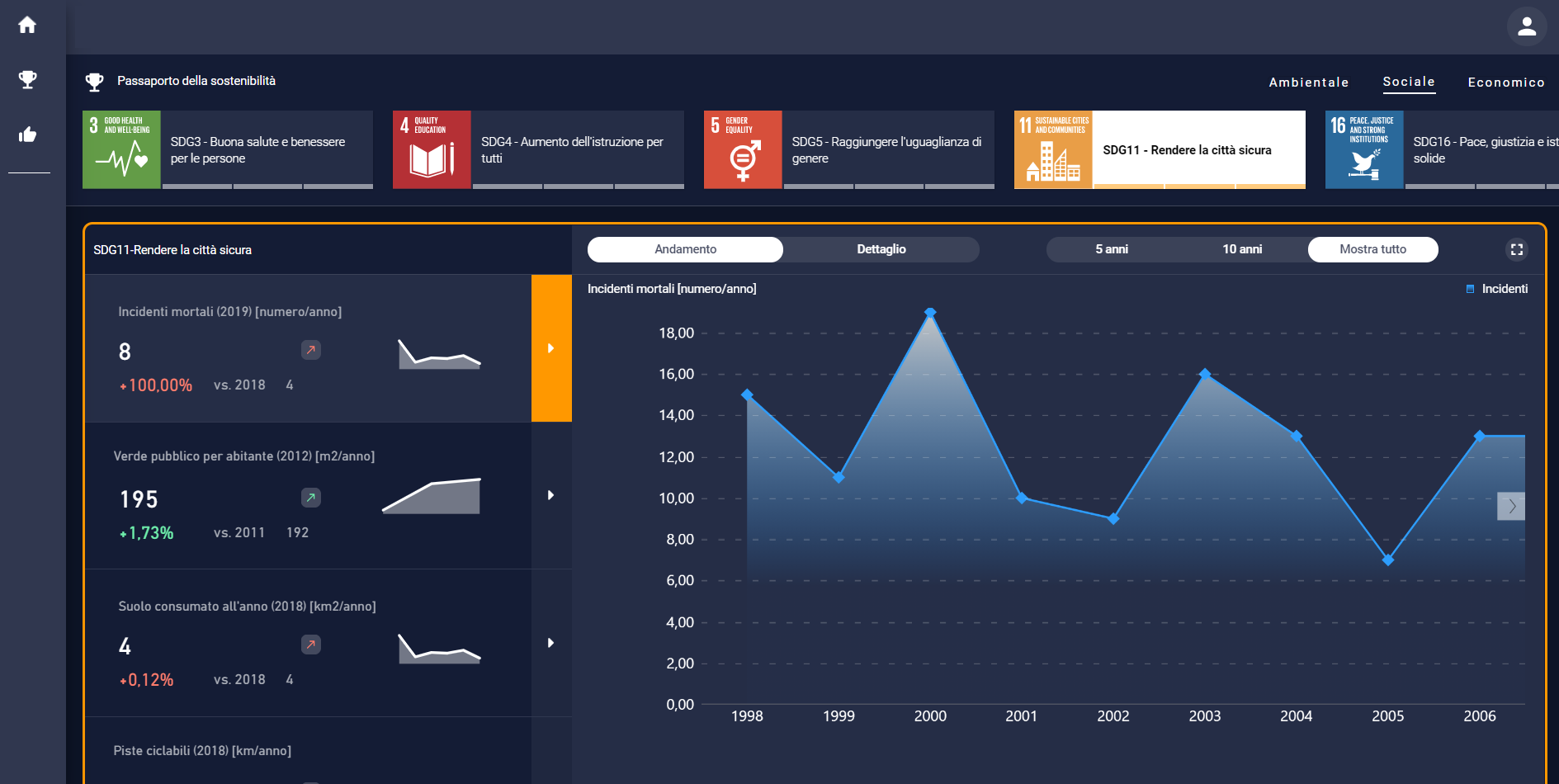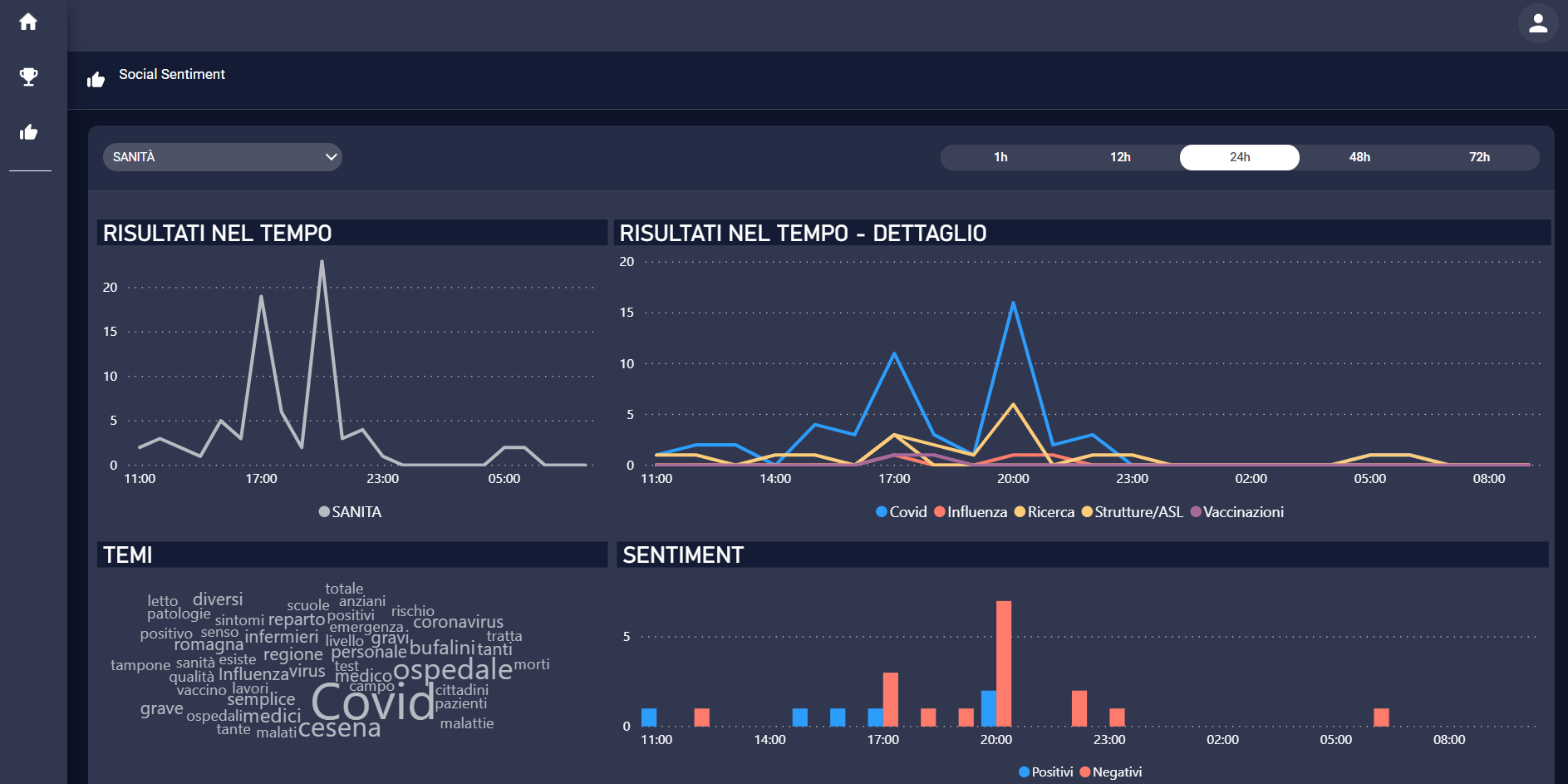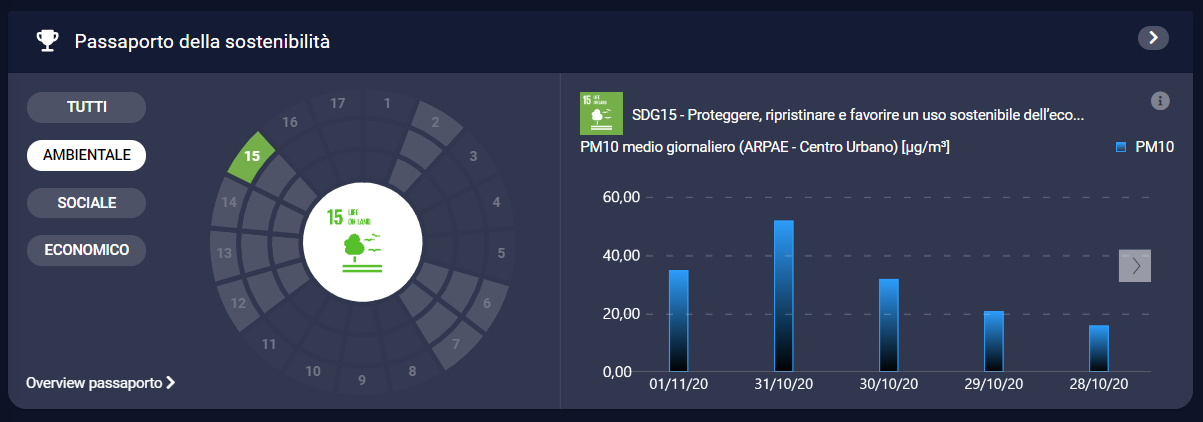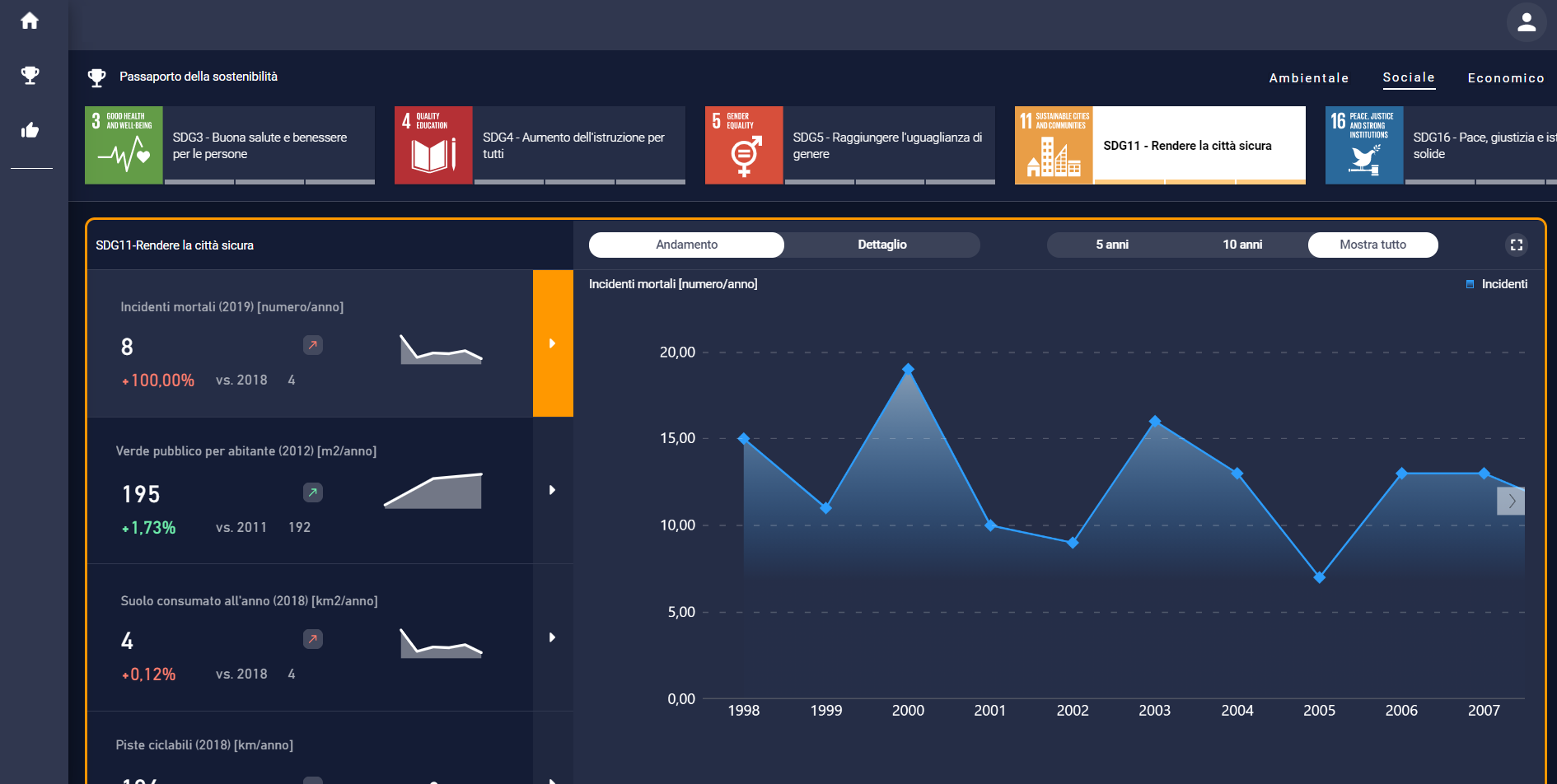PUNTOnet Board
PUNTOnet Board
- Group
- Innovation
- Smart City
- PUNTOnet Board
The large quantity of data produced by the urban sensors needs to be processed to produce information and therefore knowledge. This entails implementing hardware and software capable of communicating with the various systems (video analysis, WebGIS, air sensors, etc.) and above all putting the data present in the various silos together to generate new information and allow new assessments, grouped on a single Dashboard.
The PUNTOnet Board becomes the place to which reference can be made for city-related decisions. It is a screen on which all the necessary information can be viewed.
The services developed are:
- Sustainability passport
- Energy map
- Satellite maps
- Environmental monitoring
- Technological infrastructure
Sustainability passport
The Sustainability Passport is an innovative tool designed to enable local authorities to monitor the 17 environmental, social and economic topics of the United Nations 2030 Agenda SDGs.
In particular, the Passport was designed to allow user-friendly management of the 17 topics and related goals.
By monitoring these topics, the City Council takes part in the awareness and transformation process that leads to a conception of the local environment as a fundamental element for the sustainability challenges set by the UN 2030 Agenda SDGs.
The 17 topics will be shown in the corresponding section of the Dashboard, and each of these will be displayed in the wheel element which, thanks to bars and different colouring, shows whether or not the target has been achieved: 3 bars - green (target achieved); 2 bars - yellow (target almost achieved); 1 bar - red (target not achieved).
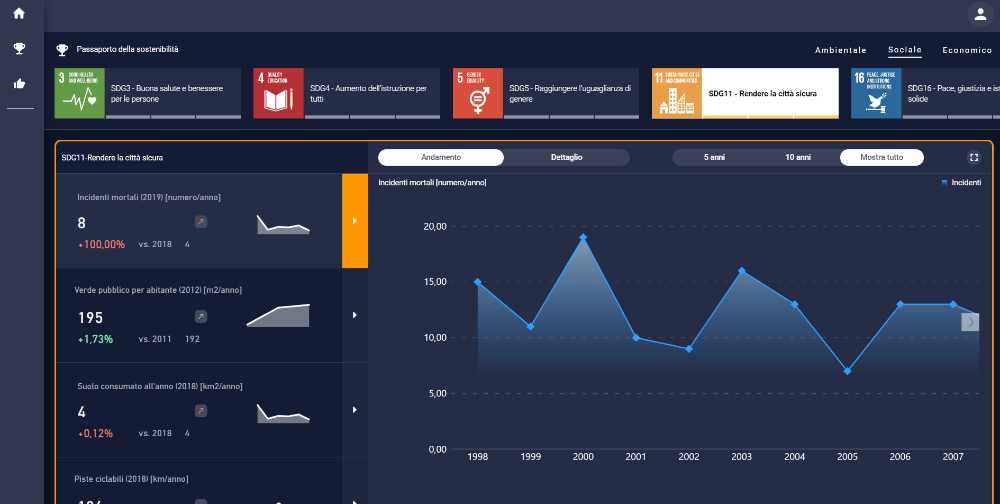
By querying the desired theme in the wheel you may gives access to a second level of the Dashboard, which provides specific information about the history and current status of the indicator. The indicator will be represented by numbers, histograms or graphs and will be compared with the target by indicating the target to be achieved, from which the bars and corresponding quality colouring will be obtained.
Energy Map
The energy map project was developed using a combination of methods associated with an analysis of big data and the integration of data coming from different sources.
In-depth knowledge of the consumption of a single building and the city as a whole is necessary to achieve high levels of efficiency.
The energy map is a service designed in a WebGIS environment for the energy analysis of buildings, enabling the assessment of the historical trend of consumption and the performance of predictive analyses. It is a useful tool for public authorities as it allows them to view consumption on a map and monitoring interface (the Dashboard).
The map allows the cross relation of consumption of gas, district heating, water, electricity and environmental hygiene to extract value-added information, such as a calculation of the building’s energy efficiency class, the relationship between water consumption and the declared number of inhabitants, the identification of the type of system and the fuel used for heating, etc.
Energy maps are therefore a tool that enables the public authorities to monitor the city and, above all, to take measures to increase energy efficiency. A detailed geographical view of energy consumption, not just current but also with historical trends, enables the authorities to design and plan concrete actions based on the analyses shown on the map.
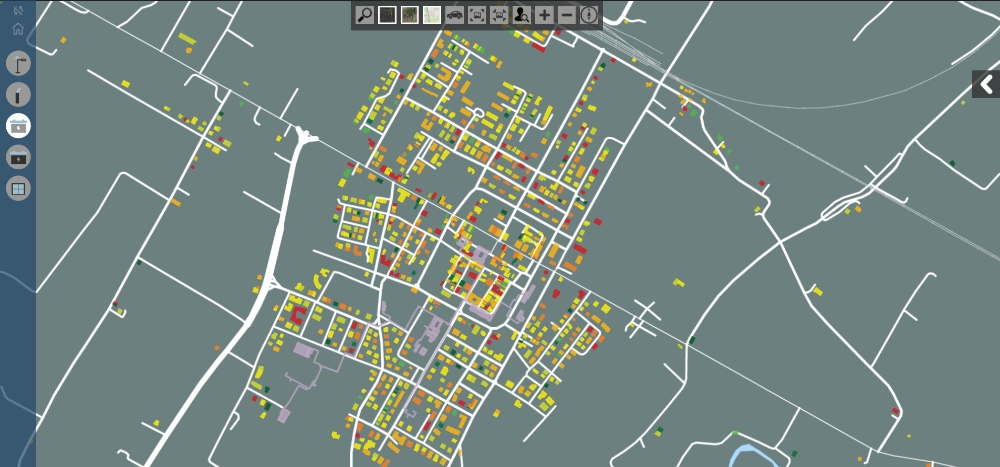
Satellite maps
The satellite, aerial (remote sensing) and SAPR (drone) mapping service uses medium-high resolution images to explore several aspects of the environment and changes that have taken place over time.
The topics of analysis are:
- Monitoring of urban greenery;
- Monitoring of land consumption;
- Mapping and registration of roofs potentially made of Asbestos-containing material (ACM);
- Mapping of potentially unauthorised buildings.
Monitoring of urban greenery was studied specially to provide the City council with an indication of how much natural area is present in the area in relation to the inhabitants during a given year, also in relation to historical periods (where data is available). This data is essential for a city to implement a transformation process tending towards local sustainable development. Consequently, the same data can be integrated with the periodic updates of topic 7 of the Sustainability Passport (Ecosystems, urban greenery and protection of biodiversity).
Land consumption is a critical topic in these years of intense focus on environmental health. The areas that, over a set period, have changed from ‘permeable’ to ‘non-permeable’ with respect to the number of inhabitants can now be quantified by remote sensing. The data can be used to update topic 1 of the Sustainability Passport (Sustainable land management and solutions based on natural processes), and will permit analyses and comparisons with the open-source data made available by the ISPRA (Italian Institute for Environmental Protection and Research).
As far as the asbestos mapping and registration activities are concerned, through image processing, the satellite, aerial and drone data can provide a complete map of the problem posed by the presence of roofs made of asbestos-containing materials (ACM). The geolocalised data may also indicate the presence of critical areas, that is, sensitive places close to roofs made of asbestos-containing materials.
Potentially unauthorised buildings can also be monitored by remote sensing, which can indicate, year by year, the impact of the problem on the local environment. To conduct these analyses correctly and accurately, the City council will be asked to provide the cadastral maps and those indicating the constraints present in the study area.
The City council, which possesses a licence for access to the RER Map-Making Service, will be asked to provide the satellite orthophotographs for the study and analyses described above.
Environmental Monitoring
The use of IoT systems enables the City council to conduct special analyses of various topics. An analysis of the environmental quality can be conducted through a network of low-cost sensors. The sensor boxes are installed at strategic points of the area, powered by the electricity network or self-powered by photovoltaic panels, and equipped with a GSM data transmission module. They can be installed stand-alone or can be built into technical infrastructure as described below.
The sensor boxes contain several sensors, in particular: Sensors for measuring atmospheric particulate concentrations: PM 10 and PM 2.5; Sensors for measuring gases in the air: Ozone (O3), Nitrogen dioxide (NO2), Carbon dioxide (CO2); Sensors for measuring the following physical parameters:Temperature (T), Relative humidity (RH).
The sensors collect all the data at a rate of around once a minute, which are sent and presented on a map that can be consulted from the Dashboard.
The collection and processing of the data will serve to identify ‘the degree’ of air quality, the sources of emission and, if necessary, measures necessary to mitigate any critical points found.

The environmental box can be equipped with a sensor for monitoring the quality of the acoustic zoning (dB) of the area. This will be used, if any critical points are found, to determine measures for reducing noise and preventing noise pollution.



